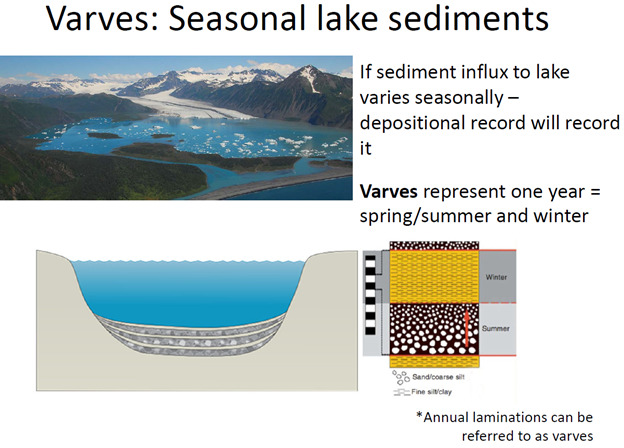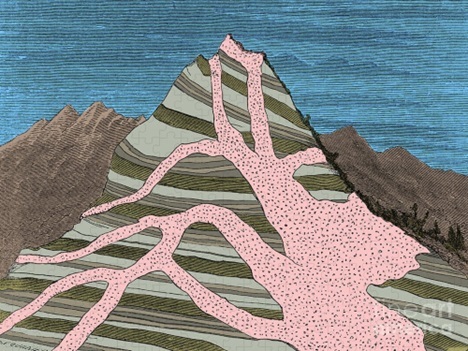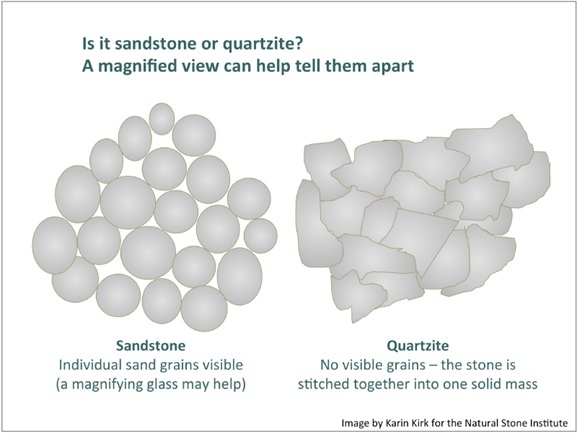DO NOT PARK IN ANY STAFF/FACULTY PARKING SPOTS, Campus Police can ticket you. I've included an additional waypoint for suggested parking.
This EarthCache will take you to 3 difference rocks on Schoolcraft College's main campus and teach you how each were formed. You will need to visit these 3 rocks and determine which kind they are. The posted coords take you to Rock 1.
TYPE 1: Varved Shale
This is a sedimentary rock that forms when deposits of clay and silt alternate at the bottom of a lakebed. In this case, varves form in glacial environments and the layers represent a sequence of annual deposits. Floodwaters in the spring time contain fine sediments such as clay and silt, along with some coarser sediments. The coarse sediments deposit first and the clay deposit last. Over time, these layered sediments get buried by more layers above them and undergo the process of lithification where they become sedimentary rocks.

TYPE 2: Granite with Intrusions
Granite is an igneous rock that forms when magma slowly crystallizes (becomes solid). This happens beneath the surface, in what is described as an intrusive igneous environment. Granite forms from magma that solidifies beneath the surface, not from lava on the surface. It is not a volcanic rock, but rather a plutonic rock. This can be a magma chamber deep underground that solidifies slowly over time to allow crystals of igneous minerals to grow and become visible within the rock.
This specific boulder contains two types of granite. The first is the darker granite and the second is the pinkish colored granite. The dark granite formed first, and at some other time after its formation, magma conduits and tunnels of different composition intruded into this older granite and what crystallized was a pink granite. So the pink lines in this rock are intrusions in a host rock.
The dark minerals include biotite and hornblende. The pink mineral is potassium feldspar. This rock also contains a fair amount of quartz.
Note: Most boulders we encounter in Michigan were once part of a rock formation that broke off by the glaciers during the last ice age that began around 2 million years ago. These boulders were then eroded by the ice and left behind as the glaciers receded. This specific boulder has some visual features (scars) of that chaotic event. Most of these boulders originate somewhere north of our location, either from the Upper Peninsula or in northern Canada.


TYPE 3: Quartzite
Quartzite is a metamorphic rock that forms from the alteration of sandstone by hear and pressure. In this case, the parent rock (sandstone) is subjected to contact metamorphism – a scenario where the parent rock is in the proximity of a heat source. Sandstone is made of sand particles, which mineralogically are mostly composed of quartz. When in the proximity of a heat source (like magma chambers or conduits), the edges of the sand grains slightly melt to fuze with their neighboring sand particles. The result is a recrystallized quartz rich rock – quartzite.


In order to claim a find on this EarthCache, you must physically visit the rocks and send me the following answers:
Use the given waypoints to identify which is Rock 1, Rock 2, and Rock 3.
1) After reading the above descriptions, which of the 3 rocks (rock 1, rock 2, or rock 3) would you believe to be quartzite and why?
2) After reading the above descriptions, which of the 3 rocks (rock 1, rock 2, or rock 3) would you believe to be the granite with intrusions and why? What is the measurement of the longest intrusion that you see?
3) After reading the above descriptions, which of the 3 rocks (rock 1, rock 2, or rock 3) would you believe to be varved shale and why?
4) Optional: Any pictures of yourself and any of the rocks are greatly appreciated but not required, just please be sure not to reveal any answers.
Special thanks to Schoolcraft College geology instructor Samer Hariri for his assistance in creating this EarthCache.